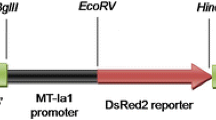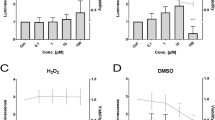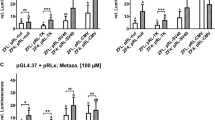Abstract
It has been proposed that transgenic zebrafish could be designed to detect low levels of chemical contaminants that cause oxidative stress in aquatic environments, such as heavy metals or pesticides. In this paper, we describe such a transgenic zebrafish that produces a luciferase–green fluorescent protein (LUC–GFP) fusion protein under conditions of oxidative stress. The reporter gene expression is under the regulation of the electrophile responsive element (EPRE), which activates gene expression in response to oxidative stressors. The GFP component of this fusion protein allows us to visually detect reporter gene activity in live animals to determine if activity is localized to a particular tissue. The luciferase component is capable of returning a quantitative assessment of reporter gene activity that allows us to determine if reporter gene activity is directly correlated to the concentration of the chemical inducer. We have tested this reporter construct in both transient and stable transgenic fish after exposure to a range of HgCl2 concentrations. GFP expression from the EPRE–LUC–GFP construct was inducible in transient assays but was below the limit of detection in stable lines. In contrast, we observed inducible luciferase activity in both transient assays and stable lines treated with HgCl2. We conclude that the EPRE is capable of driving reporter gene expression in a whole animal assay under conditions of oxidative stress. Furthermore, expression was induced at HgCl2 concentrations that do not result in obvious morphological defects, making this approach useful for the detection of low levels of oxidative contaminants in aquatic environments.





Similar content being viewed by others
References
Baranowska-Dutkiewicz B (1982) Evaluation of the skin uptake of mercuric chloride in man. J Appl Toxicol 2:223–225
Carvan MJ III, Solis WA, Gedamu L, Nebert DW (2000) Activation of transcription factors in zebrafish cell cultures by environmental pollutants. Arch Biochem Biophys 376:320–327
Carvan MJ III, Sonntag DM, Cmar CB, Cook RS, Curran MA, Miller GL (2001) Oxidative stress in zebrafish cells: potential utility of transgenic zebrafish as a deployable sentinel for site hazard ranking. Sci Total Environ 274:183–196
Dave G, Xiu RQ (1991) Toxicity of mercury, copper, nickel, lead, and cobalt to embryos and larvae of zebrafish, Brachydanio rerio. Arch Environ Contam Toxicol 21:126–134
Day RN, Kawecki M, Berry D (1998) Dual-function reporter protein for analysis of gene expression in living cells. Biotechniques 25:848–856
de Carvalho S, Lombardi JV, Paiva MJ, de Franca-Monkolski JG, Ferreira JR (2006) Bioaccumulation of mercury in fish exposed to experimentally contaminated water and sediment. Bull Environ Contam Toxicol 77:854–860
Goldman LR, Shannon MW (2001) Technical report: mercury in the environment: implications for pediatricians. Pediatrics 108:197–205
Gonzalez P, Dominique Y, Massabuau JC, Boudou A, Bourdineaud JP (2005) Comparative effects of dietary methylmercury on gene expression in liver, skeletal muscle, and brain of the zebrafish (Danio rerio). Environ Sci Technol 39:3972–3980
Guzzi G, La Porta CA (2008) Molecular mechanisms triggered by mercury. Toxicology 244:1–12
Hayashi A, Suzuki H, Itoh K, Yamamoto M, Sugiyama Y (2003) Transcription factor Nrf2 is required for the constitutive and inducible expression of multidrug resistance-associated protein 1 in mouse embryo fibroblasts. Biochem Biophys Res Commun 310:824–829
Hayes JD, Flanagan JU, Jowsey IR (2005) Glutathione transferases. Annu Rev Pharmacol Toxicol 45:51–88
Johnson DA, Andrews GK, Xu W, Johnson JA (2002) Activation of the antioxidant response element in primary cortical neuronal cultures derived from transgenic reporter mice. J Neurochem 81:1233–1241
Kensler TW, Wakabayashi N, Biswal S (2007) Cell survival responses to environmental stresses via the Keap1–Nrf2–ARE pathway. Annu Rev Pharmacol Toxicol 47:89–116
Ko SK, Yang YK, Tae J, Shin I (2006) In vivo monitoring of mercury ions using a rhodamine-based molecular probe. J Am Chem Soc 128:14150–14155
Koster RW, Fraser SE (2001) Tracing transgene expression in living zebrafish embryos. Dev Biol 233:329–346
Kwak MK, Kensler TW, Casero RA Jr (2003) Induction of phase 2 enzymes by serum oxidized polyamines through activation of Nrf2: effect of the polyamine metabolite acrolein. Biochem Biophys Res Commun 305:662–670
Linney E, Udvadia AJ (2004) Construction and detection of fluorescent, germline transgenic zebrafish. Methods Mol Biol 254:271–288
Lister JA, Robertson CP, Lepage T, Johnson SL, Raible DW (1999) nacre encodes a zebrafish microphthalmia-related protein that regulates neural-crest-derived pigment cell fate. Development 126:3757–3767
Primiano T, Kensler TW, Kuppusamy P, Zweier JL, Sutter TR (1996) Induction of hepatic heme oxygenase-1 and ferritin in rats by cancer chemopreventive dithiolethiones. Carcinogenesis 17:2291–2296
Thermes V, Grabher C, Ristoratore F, Bourrat F, Choulika A, Wittbrodt J, Joly JS (2002) I-SceI meganuclease mediates highly efficient transgenesis in fish. Mech Dev 118:91–98
Udvadia AJ, Linney E (2003) Windows into development: historic, current, and future perspectives on transgenic zebrafish. Dev Biol 256:1–17
Westerfield M (2000) The zebrafish book: a guide for the laboratory use of zebrafish (Danio rerio). University of Oregon Press, Eugene, OR
Acknowledgment
This work was supported by pilot project funding to A.J.U. from the UWM Institute of Environmental Health and the UWM Center for WATER Security (DARPA grant no. NBCH1050024).
Author information
Authors and Affiliations
Corresponding author
Rights and permissions
About this article
Cite this article
Kusik, B.W., Carvan III, M.J. & Udvadia, A.J. Detection of Mercury in Aquatic Environments Using EPRE Reporter Zebrafish. Mar Biotechnol 10, 750–757 (2008). https://doi.org/10.1007/s10126-008-9113-x
Received:
Revised:
Accepted:
Published:
Issue Date:
DOI: https://doi.org/10.1007/s10126-008-9113-x




